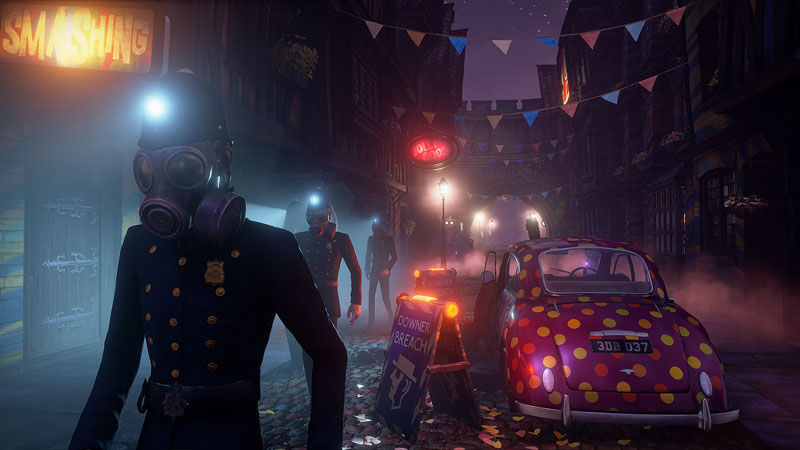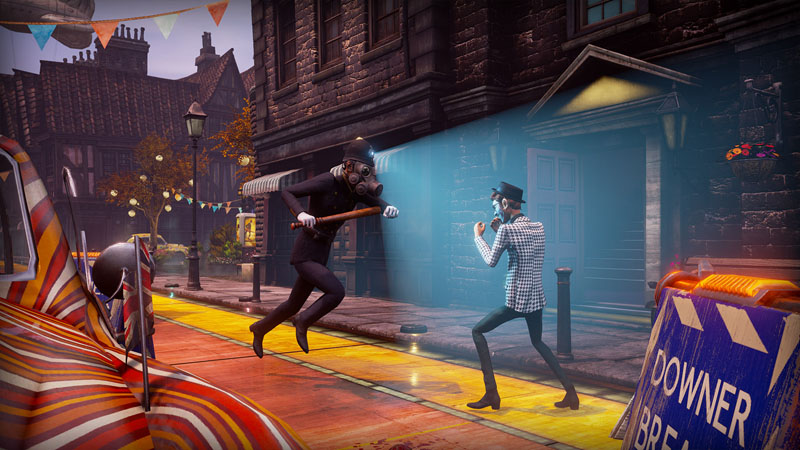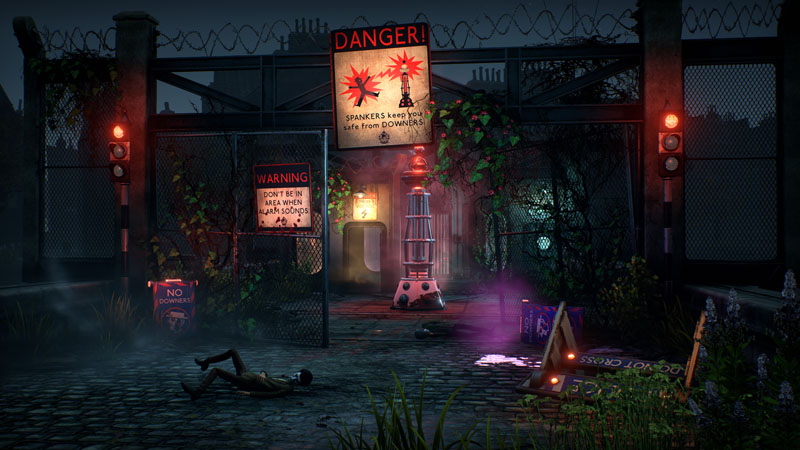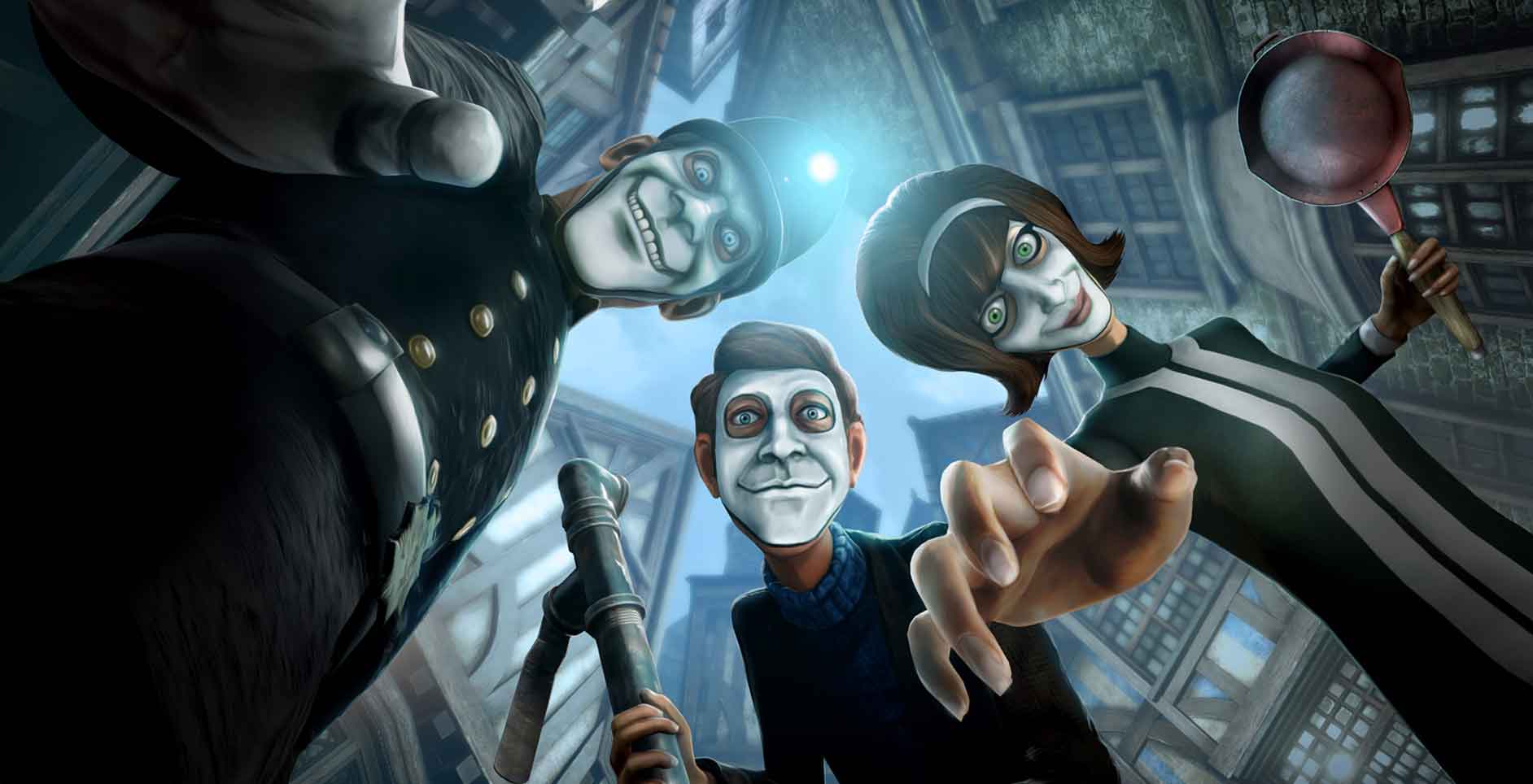It’s when the Joy, the hallucinogenic pill at the core of the We Happy Few experience, wears off that the curtain drops and the colourful facades fall away, revealing a bleak world that looks long devoid of hope in post-war Britain. Fields that appeared to be in bloom return to their true state, dead and flattened from the bombardment and occupation by Germany, the alternate-history victors of the war.
This dreadful contrast, which lends itself so well to We Happy Few’s setting, is symbolic of the game’s problematic inner workings. It can go from a thriving, joyous experience to being a tiresome slog in a heartbeat, often smothering the game’s fleeting glimpses of fun with its broken A.I. and imperfect survival aspects that often hamstring the game’s momentum.

We Happy Few has long enjoyed the spotlight during its development with the BioShock factor playing a huge part in that. I’d be lying if I said it wasn’t immediately evident that the two games share developers. Both games boast terrific settings and the writing in both shows off the developer’s rapier-sharp wit. Much like Irrational’s underwater critical darling, We Happy Few has a satisfying quest loop. While the missions seldom amount to much more than fetching items and are fairly basic in their approach, the game is helped along by the story and its bevy of twists that hook you in.
The drug Joy, We Happy Few’s gameplay element that saw it refused classification briefly in Australia, allows the player-character to blend in with the other brainwashed occupants of Wellington Wells. With pep in your step, you avoid unwanted attention from both the Bobbies and the village’s other compliant townsfolk, intent on maintaining the idyllic status quo. If you go cold turkey from Joy, you’ll suffer withdrawals that expose you as a downer, forcing you to fight or sneak through most of the game. The upswing is that you’ll have full control of your faculties so it becomes a genuine dilemma working out how best to navigate the psychedelic landscape.

Taking the aggressive approach worked for me for the most part until I hit Hamlyn Village, an early-on district of middling socioeconomic status that employs a strict hardline against downers and has a baffling list of laws that make navigating the rainbow-clad roads an utterly unenjoyable chore. Jumping is banned, despite numerous and vexing examples of townsfolk jumping playfully into puddles, though the no-running rule is the worst of the lot, reducing foot traffic to a mere amble. The game is frustratingly unforgiving when it comes to breaking these laws, also. I admit, I committed a social faux pas stepping out in a leather gimp suit I’d forgotten I’d donned but to be beaten mercilessly the instant eyes were laid on me was frustrating. Even if I worked up into a canter, distressed cries of the upstanding citizens signalled I’d soon be cut down with no recourse. Many games of this ilk gift you wriggle room, a small warning ping that acts as the harbinger of your compliance, but in We Happy Few, the repercussions seem instantaneous. There are skills you can purchase that negate these burdens, but by the time you’re able to buy them, you’ll have been worn down by the game’s inherent inconsistencies and brutal attempts to reinforce its rules.
Survival plays a huge role in navigating Wellington Wells, as you’re forced to micro-manage your character’s hunger, thirst and sleep. It’ll appeal to a few, though for the most part it just felt like busy work. It isn’t all bad as things like weapon degradation work within the game and doesn’t hamper the experience. The melee combat itself is rather straightforward and undemanding, ultimately becoming a game of shoving the enemy to stagger them and then swinging for the fences. Stealth plays its part in We Happy Few’s bustling and peaceful metropolis as a curfew is enforced on citizens, leaving only the pitter-patter of patrolling guards on the night streets. The game tries to direct you to sleep in people’s houses to pass the time but they’re so often difficult to come across I’ve opted to do my best Oscar the Grouch impersonation and hide in bins and phone-surf until the in-game morning breaks. It’s frustrating and, again, there’s a skill to offset curfew but by the time it’s in your hands the tiresome repetitiveness of peeling yourself from a trash can has long sapped your enthusiasm.

The procedural generation, despite being a handy crutch for game developers, does lead to a number of cumbersome examples of level design where buildings awkwardly meet each other at strange angles as though plopped there by a drunken divine creator who was impressed by the shrinking corridors in Willy Wonka’s famous factory. The fact that each and every house shares a wall renders every town a fortress and greatly minimises your freedom to create your own paths through town.
While the war-torn districts of Wellington Wells don’t buoy the spirit, the higher-class areas adorned with lovely art deco call to mind a cleaner, less grim BioShock. Capturing bygone eras is clearly in this developer’s wheelhouse as they’ve gone to the well once again and it’s still paying off. It’s a bit of a shame that the game is most accessible and enjoyable in the rundown areas that aren’t as appealing. The game is hardly an art installation though it’s hard to deny that the character models are rather inspired, despite them being recycled constantly throughout; though there was an attempt to write this in as a Joy side-effect, that didn’t quite wash with me. There’s something particularly dystopian about having to wear featureless, white masks, plus it makes those in authority roles astoundingly terrifying. Despite the fact some characters inexplicably vanish from existence when engaged and textures poorly render and pop like it’s going out of style, the game’s art direction gets a tick from me.
We Happy Few won’t win any awards for its actor’s performances, though they’re certainly serviceable. The game is an exhibition of pure British witticism and charm and the script services both of those things to an excellent degree. I’m one for cockney rhyming in my place of work and this game has helped me add a string or two to my bow.



